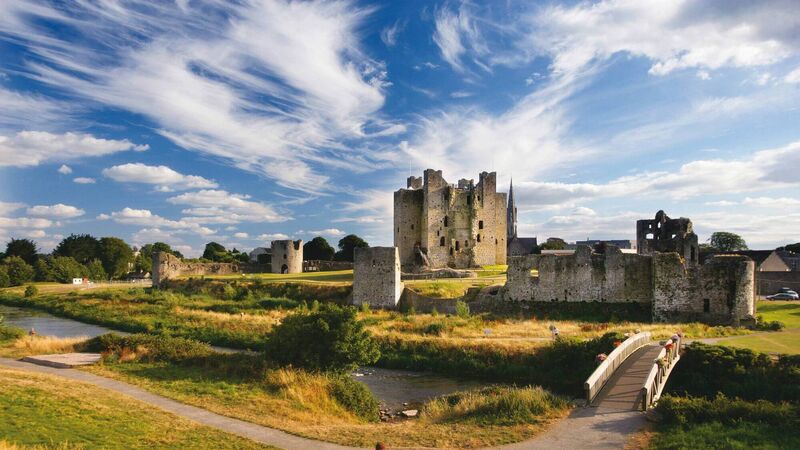Terry Prone: Restoring our heritage doesn't have to be in poor taste

Trim Castle, Co Meath: One of Ireland's finest landmarks. Restoring ruins might revivify them.
If you visit my home one of these weekends, you’ll get a fascinating tour of a Martello Tower and sample a spectacular view from the windy roof.
Many heritage homes are open again — in our case on Saturday and Sunday morning. And while we’d prefer if you wore a mask, we’re not insistent about it, knowing that climbing long narrow spiral staircases can make the climber breathless even if their mouth and nose aren’t covered with a complicating lump of cloth slung between their ears.
One of the oddities about this particular Martello Tower is that when we bought it, it had a spiral staircase going from the first floor to the roof, but no spiral staircase going down from the first floor to the ground floor.
Instead, a modern staircase allowed you to get from one to the other. This seemed to have come about when the guy who bought it from the State about a hundred years ago lost the run of himself and tore out the walls at four points. It was as if he’d put a plus sign over the tower and created holes at each of the branches of that sign.
This action was a phenomenal excursion into expensive vandalism and would have given An Taisce a conniption, had they been around at the time.
E for Effort
Still, you have to hand it to the guy. He did earn an E for effort, bearing in mind that the walls of a Martello are nine feet thick on the sea side, eight feet thick on the land side.
That’s a lot of rock to remove in the days before electric drills. But, over the course of a few years, remove it he did, which allowed later owners, in the 50s, to put a galley kitchen of malignant turquoise nastiness, inside the hole-in-the-wall at the back.
When the construction company we hired to tear away a century of awful accretions went to work, my son, a Martello tower autodidact, talked to one of them, a man named Bryan Greene, patting one of the repellent turquoise doors as he spoke.
“I think they bricked the spiral staircase into the wall behind this,” he said. “When you have the kitchen units down, maybe you’d take a Kango hammer to the wall and see what you find?”
Bryan did, and in a moment he likened to becoming a latter-day Indiana Jones, found not only the spiral staircase, but the steps of the original that the previous owners had cut away at the bottom. They’d turfed the lot into the space and cemented it all up.
We rescued the cutaway steps, cleaned them off and lined them up as they once would have been before calling Fingal County Council to come and have a look. The minute their architect saw them, she shook her head and waved a hand like a Garda motioning you in to the side because your windscreen information is iffy.
We could not reconstruct, she told us firmly. Anything we did to the tower had to be clearly differentiated from the original structure. It had to stand out as modern. So we commissioned David Sheane of Sheane Engineering in Wicklow to build steps using steel and old oak from a ships’ chandlers and, today, those form the bottom of the spiral staircase climbed by visitors on the tour of the tower.
Last week, Michael McDowell, in his column in the Irish Times, argued that our reverence for the built environment may manifest itself in unproductive ways. The burden of his tune was to point out that many wonderful structures, ranging from Trim Castle to the castle around the corner from me in Donabate, are carefully preserved as ruins, when, with a bit of vision and craftsmanship, many of them could be brought back to a fuller version of what they once were.
Cue back of the hand to forehead horror. This non-architect, this non-expert in the built legacy of this country, was doing a Prince Charles; having opinions running directly counter to the accumulated wisdom of experts. Shocking, really.
Now, while I would be reasonably careful about suggesting Michael McDowell and Prince Charles are two of a kind, it wouldn’t be the worst kind to be two of, if you follow me. Charles’s opinions on modern architecture, particularly that of the Brutalist school, have been widely ignored.
He’s dampened them down somewhat, in recent years, as the crown metaphorically hovers over his princely head. But he wasn’t wrong, you know, and neither is our own Senator McDowell. Indeed, it could be suggested that the latter didn’t go far enough.
For roughly half a century, the central dogma informing any work done on designated buildings is that authenticity is key.
So you’re not allowed to put an extension onto a building that would follow the architectural and material pattern of the original. Instead, you must stick something on top of it or alongside it that makes it look like a family forced to adopt a Martian.
I give you what used to be the Point Depot in Dublin. Or — even worse — the lovely redbrick Tropical Fruit Warehouse across the Liffey, which is now wearing a glass box on its head.
The external walls have been preserved – and an unrelated excrescence put on top. The look is akin to Pope Francis wearing a MAGA baseball cap.
This is not to criticise the architects who put the glass box on the Tropical Fruit Warehouse. They have to play by the rules. The issue is the rules themselves.
The rules may represent the consensus of all right-thinking built-environment powers-that-be, but they are leaving our cities with a godawful pattern of minimal preservation (as in, keeping the front wall intact) bowdlerised by completely unrelated and deliberately unsympathetic glass additions.
Michael McDowell wants to re-roof some of our ruins, and a pilot example should be tried out pronto. It would revive old skills and allow ruins to be filled with working, breathing, laughing humans as was once the intent.
Holograms of the unreconstructed building could be installed in order to give visitors a clear understanding of precisely where the ruin ended and the re-construction begins.
This generation is uniquely placed to ensure this more realistic preservation.
This is not to suggest shoving PVC windows into 14th century manor houses.
Every addition or modification should be supervised by the Heritage staff at each local authority and should utilise old skills and materials to ensure rigorous fidelity to the original.
When Notre Dame in Paris burned, philanthropists all over the world competed with each other to provide money for its restoration. Nobody suggested that it would be all wrong to reconstruct, and if they had, they would have been laughed at.
What form of peculiarly Irish heritage pathology dictates that we regard only ruins as fully authentic and reject the possibility of sensitively restoring our old buildings to what they were?
CONNECT WITH US TODAY
Be the first to know the latest news and updates






